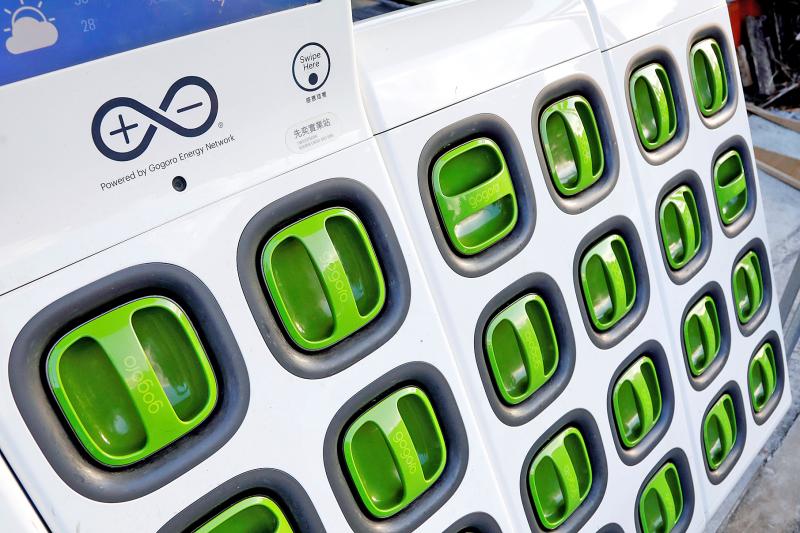Electric scooter maker Gogoro Inc (睿能創意) this year expects its number of electric battery swapping stations to outstrip the number of gas stations in the nation following seven years of deployment, a sign that electric two-wheelers are gaining traction.
As of the end of last year, Gogoro had built 2,215 GoStations nationwide, mostly in urban areas, up from 1,937 in 2020.
The number of gas stations operated by CPC Corp, Taiwan (台灣中油) and Formosa Petrochemical Corp (台塑石化) was 2,487.

Photo: Tyrone Siu, Reuters
“By the end of this year, we are very confident that the number of battery swapping stations will surpass the number of gas stations nationwide,” Gogoro vice president for energy services Alan Pan (潘璟倫) told a news conference yesterday.
Gorogo aims to deploy more large-scale electric battery swapping stations, dubbed Super GoStations, and other stations in collaboration with government agencies, Pan said.
The company also plans to add battery stations in more remote areas, he said.
Gogoro’s 453,300 riders can swap batteries at GoStations located in 7-Eleven convenience stores, and even one in Nantou County’s Wuling (武嶺) on Hehuanshan (合歡山), the highest highway in Taiwan.
New vehicle sales by Gogoro and its partners in the Powered by Gogoro Network (PBGN) contracted 5.2 percent year-on-year to 93,999 units last year, outperforming the overall scooter market, in which sales plunged 21.9 percent year-on-year.
PBGN members include Yamaha Motor Co, Aeon Motor Co (宏佳騰), Motive Power Industry Co (摩特動力) and Suzuki Motor Corp.
Gogoro chief product officer Peng Ming-i (彭明義) expects new electric vehicle sales to return to growth this year.
The penetration rate of electric scooters is also forecast to climb this year, compared with 11.6 percent last year, up from 9.6 percent in 2020.
Peng declined to provide further forecasts ahead of Gogoro’s debut on the US market.
Gogoro, Yamaha, Aeon and Suzuki are scheduled to launch new models later this year, which would also provide growth momentum.

CHIP RACE: Three years of overbroad export controls drove foreign competitors to pursue their own AI chips, and ‘cost US taxpayers billions of dollars,’ Nvidia said China has figured out the US strategy for allowing it to buy Nvidia Corp’s H200s and is rejecting the artificial intelligence (AI) chip in favor of domestically developed semiconductors, White House AI adviser David Sacks said, citing news reports. US President Donald Trump on Monday said that he would allow shipments of Nvidia’s H200 chips to China, part of an administration effort backed by Sacks to challenge Chinese tech champions such as Huawei Technologies Co (華為) by bringing US competition to their home market. On Friday, Sacks signaled that he was uncertain about whether that approach would work. “They’re rejecting our chips,” Sacks

Taiwan’s long-term economic competitiveness will hinge not only on national champions like Taiwan Semiconductor Manufacturing Co. (TSMC, 台積電) but also on the widespread adoption of artificial intelligence (AI) and other emerging technologies, a US-based scholar has said. At a lecture in Taipei on Tuesday, Jeffrey Ding, assistant professor of political science at the George Washington University and author of "Technology and the Rise of Great Powers," argued that historical experience shows that general-purpose technologies (GPTs) — such as electricity, computers and now AI — shape long-term economic advantages through their diffusion across the broader economy. "What really matters is not who pioneers

BUBBLE? Only a handful of companies are seeing rapid revenue growth and higher valuations, and it is not enough to call the AI trend a transformation, an analyst said Artificial intelligence (AI) is entering a more challenging phase next year as companies move beyond experimentation and begin demanding clear financial returns from a technology that has delivered big gains to only a small group of early adopters, PricewaterhouseCoopers (PwC) Taiwan said yesterday. Most organizations have been able to justify AI investments through cost recovery or modest efficiency gains, but few have achieved meaningful revenue growth or long-term competitive advantage, the consultancy said in its 2026 AI Business Predictions report. This growing performance gap is forcing executives to reconsider how AI is deployed across their organizations, it said. “Many companies

China Vanke Co (萬科), China’s last major developer to have so far avoided default amid an unprecedented property crisis, has been left with little time to keep debt failure at bay after creditors spurned its proposal to push back a looming bond payment. Once China’s biggest homebuilder by sales, Vanke failed to obtain sufficient support for its plan to delay paying the 2 billion yuan (US$283.51 million) note due today, a filing to the National Association of Financial Market Institutional Investors showed late on Saturday. The proposal, along with two others on the ballot, would have allowed a one-year extension. All three